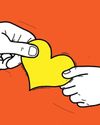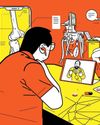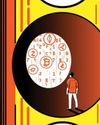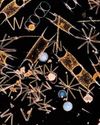
There’s a tree stump on a grassy patch in the financial district of Singapore. It’s not of a real tree, but a 3D-printed artwork created in honour of Changi Tree (also called Time Tree), the city-state’s tallest at 76 m. The artwork, the largest 3D-printed structure in Singapore, is meant to reflect the passage of time, and is a fascinating glimpse at what the tree would’ve looked like if it hadn’t been chopped down during World War II, to prevent the Japanese from using it as a ranging point. And yet, turn a phone on the artificial stump, and suddenly it starts spiralling inward. The spirals are made of text that mention important events in Singapore’s history, and indicate how humans mark the passage of time.
The Time Tree is one of six street artworks, part of Singapore Art Week, which uses augmented reality (AR), a combination of the real and virtual where physical objects are augmented with perceptual and sensory information using technology. It creates an interactive interface between the artwork and the viewer. This confluence of the world of art and AR have opened up new possibilities, helping free art from the confines of galleries and reach a whole new audience.
“AR offers the chance to contextualise artworks in Singapore by engaging visitors in new ways,” says Kay Poh Gek Vasey, chief connecting officer of technology studio MeshMinds. “Through AR, we can engage viewers to have a deeper curiosity, understanding, and memory of the artist and the artwork. By harnessing digital technologies we hope to increase public participation in the arts.”
هذه القصة مأخوذة من طبعة March 13, 2020 من Forbes India.
ابدأ النسخة التجريبية المجانية من Magzter GOLD لمدة 7 أيام للوصول إلى آلاف القصص المتميزة المنسقة وأكثر من 9,000 مجلة وصحيفة.
بالفعل مشترك ? تسجيل الدخول
هذه القصة مأخوذة من طبعة March 13, 2020 من Forbes India.
ابدأ النسخة التجريبية المجانية من Magzter GOLD لمدة 7 أيام للوصول إلى آلاف القصص المتميزة المنسقة وأكثر من 9,000 مجلة وصحيفة.
بالفعل مشترك? تسجيل الدخول

Home-Cooked Meal Is Now Greatly Valued
The pandemic has also brought with it an improved focus on hygiene, use of technology in dining, rise of cloud kitchens and resurgence in popularity of Indian ingredients

Paytm 3.0 - Reaching Near Breakeven In Two Years
As of 2020, Vijay Shekhar Sharma’s super app for financial services had run up losses in thousands of crores. Now, as digital payments gets yet another boost courtesy Covid-19, he’s hopeful of reaching near breakeven in two years

THE PANDEMIC HAS CAUSED WOMEN GREATER LABOUR PAIN
Covid-19 has shown that women are more likely to face the brunt of job losses than men, and find fewer opportunities when they want to resume. That apart, several have to deal with increased hours of unpaid work at home and even domestic abuse

LEADERSHIP WILL BE ABOUT SEEING THE BIGGER PICTURE
Leaders must not only guard their teams first during a crisis, but also deal with stakeholders with respect and dignity. And apart from pursuing business goals, they should remain committed to our planet and the environment

PHILANTHROPY SHOULD BE HUMBLE, BUT NOT MODEST
Apart from building a flexible and resilient framework for the future, philanthropists, civil society and the government must work in tandem so that every rupee is absorbed on the ground

INTEGRATED HEALTH CARE, TECH WILL DISRUPT SECTOR
While clinical research will get a boost, having a skilled workforce and public spending on health care will be challenges in the near term

DIGITALISATION WILL HELP IN VALUE CREATION
As the pandemic brings technology and innovation to the core of business and daily life, the next decade will see about 150 million digital-first families in India

Industry 4.0: Climate Revolution?
Augmenting sustainability alongside digital capabilities is an economic, competitive and global opportunity for India’s businesses, but regulations need to reflect intent

EV Dream Still Miles Away
Electric vehicles have remained a buzzword in India for years. But not much has moved on ground due to high upfront costs, range anxiety and charging infrastructure

Living Waters
A virus has caused us to scramble for oxygen but our chokehold on the environment is slowly strangling the very waters that breathe life into us. The virus is a timely reminder: We are merely consumers, not producers of life’s breath on this planet